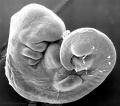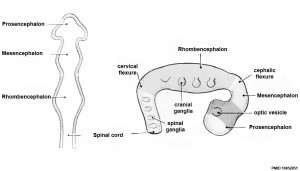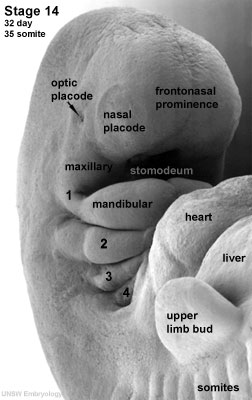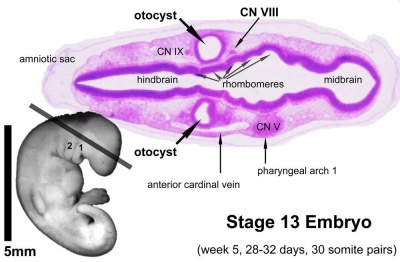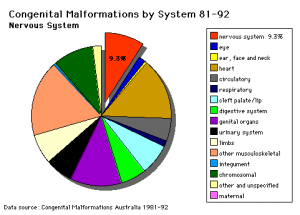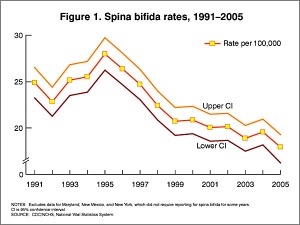BGDA Practical 7 - Week 4: Difference between revisions
mNo edit summary |
|||
| Line 1: | Line 1: | ||
==Introduction== | ==Introduction== | ||
{{ | {{BGDALab7}} | ||
[[File:Stage11_sem6.jpg|thumb|300px|Human embryo (Week 4, 24 days, Carnegie stage 11, 13 somite pairs)]] | [[File:Stage11_sem6.jpg|thumb|300px|Human embryo (Week 4, 24 days, Carnegie stage 11, 13 somite pairs)]] | ||
| Line 134: | Line 134: | ||
{{BGDALab7}} | {{BGDALab7}} | ||
| Line 169: | Line 166: | ||
---- | ---- | ||
{| class="prettytable" | {| class="prettytable" | ||
| | |-bgcolor="FAF5FF" | ||
| width= | | <center>'''Day'''</center> | ||
| width=100px | <center>'''Stage'''</center> | |||
| '''Event''' | | '''Event''' | ||
| Line 180: | Line 177: | ||
| [[File:Stage10_dorsal1.jpg|200px]] [[File:Stage10-dorsal2.jpg|200px]] | | [[File:Stage10_dorsal1.jpg|200px]] [[File:Stage10-dorsal2.jpg|200px]] | ||
[ | [[Neural_Crest_Development|Neural Crest]] - differentiation at spinal cord level from day 22 until day 26 | ||
[[Neural_System_Development|Neural]] - neural folds begin to fuse near the junction between brain and spinal cord, when [[Neural_Crest_Development|Neural Crest]] - cells are arising mainly from the neural ectoderm | |||
[[Neural_Crest_Development|Neural Crest]] - trigeminal, facial, and postotic ganglia components visible<ref><pubmed>17848161</pubmed></ref> | |||
[[Neural_Crest_Development|Neural Crest]] - migration of vagal level neural crest cells begins (7-10 somite stage) | |||
[ | [[Neural_System_Development|Neural]] - Brain rostral neural tube forms 3 primary brain vesicles (week 4) | ||
[ | [[Respiratory_System_Development|Respire]] - Week 4 laryngotracheal groove forms on floor foregut. | ||
|- | |- | ||
| <center>23</center> | | <center>23</center> | ||
| | | | ||
| [ | | [[Cardiovascular_System_Development|Heart]] - begins to beat in Humans by day 22-23, first functioning embryonic organ formed. | ||
|- | |- | ||
| Line 203: | Line 199: | ||
| [[File:Stage11_bf1c.jpg|200px|link=Carnegie stage 11]] | | [[File:Stage11_bf1c.jpg|200px|link=Carnegie stage 11]] | ||
[ | [[Endocrine_-_Thyroid_Development|Thyroid]] - thyroid median endodermal thickening in the floor of pharynx | ||
[ | [[Neural_System_Development|Neural]] - rostral (or cephalic) neuropore closes within a few hours; closure is bidirectional, it takes place from the dorsal and terminal lips and may occur in two areas simultaneously. The two lips, however, behave differently. | ||
Optic ventricle appears | Optic ventricle appears | ||
| Line 214: | Line 210: | ||
| [[File:Stage12_bf1c.jpg|200px|link=Carnegie stage 12]] | | [[File:Stage12_bf1c.jpg|200px|link=Carnegie stage 12]] | ||
[ | [[Endocrine_-_Pituitary_Development|Pituitary]] - Week 4 hypophysial pouch, Rathke's pouch, diverticulum from roof | ||
[ | [[Gastrointestinal_Tract_-_Liver_Development|Liver Development]] septum transversum forming liver stroma and hepatic diverticulum forming hepatic trabeculae<ref><pubmed>9407542</pubmed></ref> | ||
[ | [[Neural_System_Development|Neural]] - caudal neuropore takes a day to close (closure is approximately at future somitic pair 31/sacral vertebra 2) | ||
[ | [[Neural_System_Development|Neural]] - secondary neurulation begins | ||
[ | [[Neural_Crest_Development|Neural Crest]] - cardiac crest, neural crest from rhombomeres 6 and 7 that migrates to pharyngeal arch 3 and from there the truncus arteriosus<ref><pubmed>17848161</pubmed></ref> | ||
[ | [[Neural_Crest_Development|Neural Crest]] - vagal neural crest enter the foregut (20-25 somite stage) | ||
|- | |- | ||
| Line 239: | Line 235: | ||
| <center>28</center> | | <center>28</center> | ||
| [[Carnegie_stage_13|Stage 13]] | | [[Carnegie_stage_13|Stage 13]] | ||
| [[File:Stage13_bf1c.jpg|200px|link=Carnegie stage 13]] [ | | [[File:Stage13_bf1c.jpg|200px|link=Carnegie stage 13]] [[Neural_System_Development|Neural]] - the neural tube is normally completely closed, ventricular system now separated from amniotic fluid. Neural crest at spinal level is segregating, and spinal ganglia are in series with the somites. Spinal cord ventral roots beginning to develop.<ref><pubmed>3354839</pubmed></ref> | ||
telencephalon cavity appears | telencephalon cavity appears | ||
[ | [[Gastrointestinal_Tract_-_Liver_Development|Liver Development]] epithelial cord proliferation enmeshing stromal capillaries<ref><pubmed>9407542</pubmed></ref> | ||
[ | [[Sensory_-_Smell_Development|Sense - Smell]] Crest comes from the nasal plates<ref><pubmed>15604533</pubmed></ref> | ||
[ | [[Integumentary_System_Development|Skin]] - 4 weeks simple ectoderm epithelium over mesenchyme | ||
[ | [[Integumentary_System_Development|Skin]] - 1 to 3 months ectoderm - germinative (basal) cell repeated division of generates stratified epithelium; mesoderm - differentiates into connective tissue and blood vessels | ||
|} | |} | ||
{{ | |||
{{BGDALab7}} | |||
[[Category:Week 4]] | [[Category:Week 4]] | ||
Revision as of 10:05, 20 May 2013
Introduction
| Practical 6: Week 3 | Week 4 | Week 5 | Week 6 | Week 7 | Week 8 |
Key Events of Human Development during the fourth week (week 4) following fertilization or Clinical week 6 (LMP).
These notes cover the fourth week of embryonic development, which is the beginning of organogenesis, (specific tissues and systems are beginning to differentiate) from the trilaminar embryo. With many parallel processes, descriptions begin to get complicated! Many of the described processes begin and extend over a broader range of time. Some developmental processes will be discussed later in the practical to simplify matters.
Ectoderm on the embryo surface undergoes segmentation: The central portion of the embryonic disc forms the neural plate, the edge of this plate forms neural crest and the remainder outside this forms the epitheium of the skin and other structures.
Neurogenesis
- Central Nervous System (CNS) - the neural plate undergoes morphological changes to form the primitive central nervous system (brain, spinal cord). An epithelial layer of cells which contributes all neural (brain, spinal cord, peripheral nervous system) and the external epithelium (surface layer of the skin) of the embryo. Neurogenesis begins towards the end of week 3, when the neural tissues separate from this germ cell layer.
- Peripheral Nervous System (PNS) - the neural crest cells in the body region migrate and spread to different regions of the embryo forming the PNS (dorsal root ganglia, sympathetic ganglia, enteric nervous system) and many other embryonic tissues. Neural crest cells in the head region form skeletal and other structures.
Pharyngeal Arches
In the head region, a series of ventral folds form under the brain in a rostral to caudal sequence, these are the pharyngeal arches.
Placodes
In the head region, ectoderm small patches form pairs of specialised placodes that eventually contribute to specific sensory components, cranial ganglia and the anterior pituitary (adenohypophysis).
Limb Buds
In the body region, limb buds form initially as ectoderm and mesoderm (somitic and somatic) components and are the "paddle-like" projections from the trunk which will form all the upper and lower limb components. (An overview of limb development will be covered in week 8).
Cardiogenesis
Within the embryo mesoderm, the heart tube and vascular development continues. Cardiogenesis will be covered in week 5, when septation begins.
Note there is also an online tutorial (developed by an ILP student) that will introduce heart development. The best place to start is with Basic Cardiac Embryology.
Neurogenesis
Developmental sequence: neural plate -> (day 18-19) neural groove -> neural tube -> Central Nervous System (brain and spinal cord)
- Central Nervous System (CNS) - the neural plate undergoes morphological changes to form the primitive central nervous system. An epithelial layer of cells which contributes all neural (brain, spinal cord, peripheral nervous system) and the external epithelium (surface layer of the skin) of the embryo. Neurogenesis begins towards the end of week 3, when the neural tissues separate from this germ cell layer.
- Peripheral Nervous System (PNS) - the neural crest cells in the body region migrate and spread to different regions of the embryo forming the PNS and many other embryonic tissues. Neural crest cells in the head region form skeletal and other structures.
Human Neuralation - Early Stages
The stages below refer to specific Carneigie stages of development.
- stage 8 (about 18 postovulatory days) neural groove and folds are first seen
- stage 9 the three main divisions of the brain, which are not cerebral vesicles, can be distinguished while the neural groove is still completely open
- stage 10 (two days later) neural folds begin to fuse near the junction between brain and spinal cord, when neural crest cells are arising mainly from the neural ectoderm
- stage 11 (about 24 days) the cranial neuropore (rostral, cephalic or anterior) closes within a few hours; closure is bidirectional, it takes place from the dorsal and terminal lips and may occur in several areas simultaneously. The two lips, however, behave differently.
- stage 12 (about 26 days) The caudal (posterior) neuropore takes a day to close
- the level of final closure is approximately at future somitic pair 31
- corresponds to the level of sacral vertebra 2
- stage 13 (4 weeks) the neural tube is normally completely closed (More? neural tube defects)
Three primary brain vesicles develop initially due to the neural plate being broader at the cranial (brain) end than the narrower caudal (spinal cord) end. When the plate fuses to form a tube, these 3 initial expansions (vesicles) result.
Pharyngeal Arches and Placodes
In the head region, two main components of head development form the pharyngeal arches and sensory placodes.
- Pharyngeal arches form a series of ventral folds under the brain in a rostral to caudal sequence. These arches will form most of the head and neck structures of the embryo and contain all three germ layers (ectoderm, mesoderm and endoderm). The topic of head and sensory development is covered in detail in BGD cycle B.
- Small patches of ectoderm form pairs of specialised placodes that eventually contribute to specific sensory components, cranial ganglia and the anterior pituitary (adenohypophysis).
Embryo Stage 13
Movies - Embryo Carnegie stage 13 - These are rotating animations based upon reconstruction of individual serial slice images of the stage 13 embryo.
| Central Nervous System | Gastrointestinal | Cardiovascular |
Week 4 Movies
Note that many of the movies start in week 4 and continue on through later embryonic development.
Ectoderm
| Neural Plate | Neural Tube |
Mesoderm
| Mesoderm | Somite Structures | Vertebra |
Endoderm
| Practical 6: Week 3 | Week 4 | Week 5 | Week 6 | Week 7 | Week 8 |
Neural Abnormalities
See also Neural Abnormalities
Neural Tube Defects (NTD)
- Failure of neural tube closure either incorrectly or incomplete.
- Dysraphism is the term often used to describe the defective fusion of the neural folds. The position and degree of failure of fusion will result in either embryonic death or a range of different neural defects. The way (mode) in which the human neural tube fuses has been a source of contention. In humans, fusion appears to initiate at multiple sites but the mode is different from that found in many animal models used in developmental studies. Severity dependent upon level within the tube and degree of failure (caudal - spina bifida; cranial - anancephaly)
Maternal Diet - Folate
Research demonstrated that that supplementation of maternal diet with folate reduces incidence of NTDs (More? Folic Acid and Neural Tube Defects)
UK
A randomised controlled trial conducted by the Medical Research Council of the United Kingdom demonstrated a 72% reduction in risk of recurrence by periconceptional (ie before and after conception) folic acid supplementation (4mg daily).
USA
Women who have one infant with a neural tube defect have a significantly increased risk of recurrence (40-50 per thousand compared with 2 per thousand for all births)
- Food and Drug Administration (USA) in 1996 authorized that all enriched cereal grain products be fortified with folic acid, with optional fortification beginning in March 1996 and mandatory fortification in January 1998. The data in the above graphs show the subsequent changes in anencephaly and spina bifida rate over that period.
Australia
- NHMRC policy statement (1993) emphasises the need for women who are capable of getting pregnant, or who are planning a pregnancy to be advised about folate and the importance of increasing folate intake to 0.4 - 0.5mg daily.
- Food Standards (FSANZ) had allowed industry two years to prepare to add folic acid to wheat flour used in making bread. Wheat flour will contain folic acid by 13 September 2009.
Links: Victoria - Folate information for health professionals | NHMRC - Nutrient Reference Values for Australia and New Zealand Including Recommended Dietary Intakes | NHMRC - Iodine supplementation for Pregnant and Breastfeeding Women
| Event | ||
| Stage 10 | 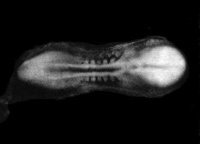 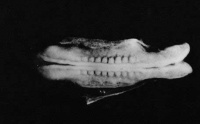
Neural Crest - differentiation at spinal cord level from day 22 until day 26 Neural - neural folds begin to fuse near the junction between brain and spinal cord, when Neural Crest - cells are arising mainly from the neural ectoderm Neural Crest - trigeminal, facial, and postotic ganglia components visible[1] Neural Crest - migration of vagal level neural crest cells begins (7-10 somite stage) Neural - Brain rostral neural tube forms 3 primary brain vesicles (week 4) Respire - Week 4 laryngotracheal groove forms on floor foregut. | |
| Heart - begins to beat in Humans by day 22-23, first functioning embryonic organ formed. | ||
| Stage 11 | 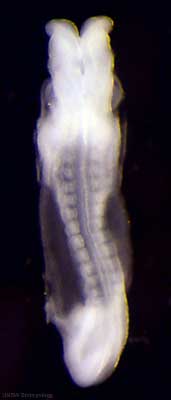
Thyroid - thyroid median endodermal thickening in the floor of pharynx Neural - rostral (or cephalic) neuropore closes within a few hours; closure is bidirectional, it takes place from the dorsal and terminal lips and may occur in two areas simultaneously. The two lips, however, behave differently. Optic ventricle appears | |
| Stage 12 | 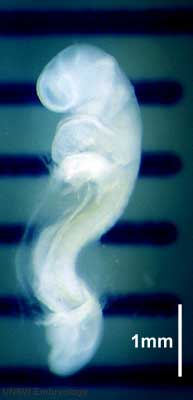
Pituitary - Week 4 hypophysial pouch, Rathke's pouch, diverticulum from roof Liver Development septum transversum forming liver stroma and hepatic diverticulum forming hepatic trabeculae[2] Neural - caudal neuropore takes a day to close (closure is approximately at future somitic pair 31/sacral vertebra 2) Neural - secondary neurulation begins Neural Crest - cardiac crest, neural crest from rhombomeres 6 and 7 that migrates to pharyngeal arch 3 and from there the truncus arteriosus[3] Neural Crest - vagal neural crest enter the foregut (20-25 somite stage) | |
| Stage 13 | 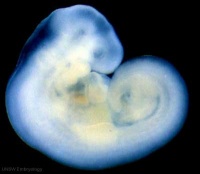 Neural - the neural tube is normally completely closed, ventricular system now separated from amniotic fluid. Neural crest at spinal level is segregating, and spinal ganglia are in series with the somites. Spinal cord ventral roots beginning to develop.[4] Neural - the neural tube is normally completely closed, ventricular system now separated from amniotic fluid. Neural crest at spinal level is segregating, and spinal ganglia are in series with the somites. Spinal cord ventral roots beginning to develop.[4]
telencephalon cavity appears Liver Development epithelial cord proliferation enmeshing stromal capillaries[5] Sense - Smell Crest comes from the nasal plates[6] Skin - 4 weeks simple ectoderm epithelium over mesenchyme Skin - 1 to 3 months ectoderm - germinative (basal) cell repeated division of generates stratified epithelium; mesoderm - differentiates into connective tissue and blood vessels |
| Practical 6: Week 3 | Week 4 | Week 5 | Week 6 | Week 7 | Week 8 |




